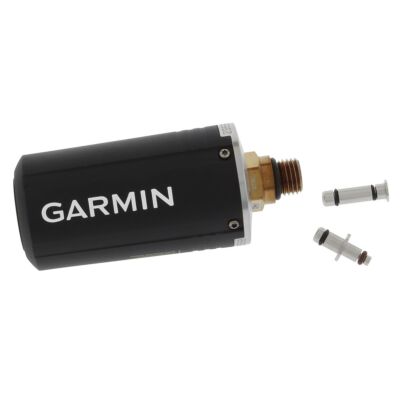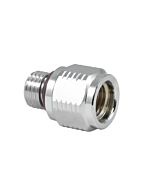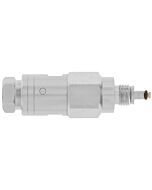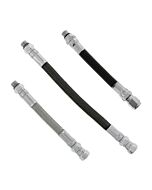Garmin Descent T2 Tank Pod Transceiver
- Pairs ONLY with the Garmin brand MK2i, MK3i, and X50i model dive computers
- Take pressure transmission range of {33 feet | 10 meters}
- Depth rating of {660 fsw | 200 msw}
- User replaceable CR123 battery, typical battery life is 100 hours of diving
- Dive messaging range up to {98 ft | 30 m} requires Descent Mk3i dive computer
Garmin Descent T2 Tank Pod Transceiver
Get tank pressure and battery remaining sent to paired compatible Descent dive computers that will then also compute gas time remaining and gas consumption rate. Monitor up to eight (8) transceivers via SubWave™ sonar technology so you can dive with multiple tanks or monitor transceivers of other divers in your group when they are within {33 feet | 10 meters}. The T2 can be mounted directly on to the standard HP port of a SCUBA first stage or with the addition of the included swivel adapter (aka "air spool") it can be installed on the end of a high-pressure SCUBA hose. Often called "air integration", the T2 tank pod is currently only supported by the Garmin air integrated model dive computers. The T2 tank pod is NOT supported by the Mk1, Mk2 (without the 'i'), Mk2s, Mk3 (without the 'i'), G1 or X30 models; nor is it compatible with any other brand of dive computer.
- Tank pressure transmission range (surface via ANT, underwater via SubWave): Up to {33 feet | 10 meters}
- Dive messaging range up to {98 ft | 30 m} requires Descent Mk3i or X50i dive computer
- Depth rating: {660 fsw | 200 msw}
- Gas Pressure rating: {4351 psi | 300 bar}
- Physical Dimensions: {3.33 x 1.44 x 1.44 in | 84.50 x 36.52 x 36.52 mm }
- Battery: Up to 100 hours, using user changeable and widely available 3V CR123A lithium
- Thread type: 7/16-inch UNF (standard HP fitting used in SCUBA)
- Surface operating temperature: From -20 to 60°C (from -4 to 140°F)
- Underwater operating temperature: From 0 to 40°C (from 32 to 104°F)
- Tank pressure is ±5% full scale accuracy
What's in the box: Garmin Descent T2 tank pod (aka tank pressure transceiver) with installed CR123A battery, flow restrictor, swivel adapter (aka 'air spool') for use with HP hoses, and quick start user guide.
The Descent T2 should always be installed using either a flow restrictor or an air spool, both included with this kit. Which one is used depends on the method of installation. The flow restrictor should be installed on a Descent T2 when it is attached directly to the high pressure port on a first stage regulator. When the T2 is attached to a high pressure hose, the air spool should be used. Using the transmitter without either the flow restrictor or air spool could result in serious injury or death from an air pressurization failure. Refer to the Descent T2 Manual for more details.
In rare cases, the body of some first stage regulator designs will have hose ports oriented such there is not room to accept a wireless tank pressure transmitter without interfering with hose routing. The solution is to use a standoff adapter, or some divers prefer to use a short HP hose in place of the standoff. All high pressure hoses use an 'air spool' with two tiny o-rings to mate the swivel connector on the hose to the fitting, and the T2 package includes a special air spool for use with standard HP hoses. The design of the T2 tank pod is such that it's use with a standard HP hose requires the special air spool included with the transceiver package.
The T2 communicates underwater using an audible sonar signal, meaning the T2 emits a half second "chirp" every 4 seconds. Garmin says the sound is normal, and the volume can be lowered by reducing the power setting of the T2 and in some cases by repositioning the T2. Most divers (especially those that wear a hood) don't notice the sound or find it indistinguishable from background noise, but some divers do report finding the sound of the T2 to be annoying.
| Brand | Garmin |
|---|---|
| SKU | GM-010-13308-00 |
| Weight | 0.250000 |
Customer Reviews
About Gas Time Remaining (GTR) Calculations
Some dive computers have the ability to monitor a sensor that allows them to provide a digital display of the gas pressure in the dive cylinder. This feature is often referred to as 'air integration' (AI) but since nearly all modern dive computers are capable of handing a variety of breathing gases the term air is a misnomer. A few of the AI computers go a step further and use the tank pressure to calculate an estimate of the breathing gas time remaining (GTR). There are a variety of different methods and formulas for GTR calculations but they all share limitations such that, for specific divers and specific dives, the GTR displayed by your computer can be wildly inaccurate.
Just to be clear, the accuracy of the GTR is not a limitation of the computer or the transmitter but because there are simply too many unknowns to make the GTR anything other than a gross approximation. Beyond the obvious factors such as environment, depth variations in a multi-level dive profile, ascent rates, and stop times; the divers gas consumption rate will vary greatly depending on changes in equipment configuration and exertion. For this reason, GTR estimates are meaningless on most technical dives and even some deeper sport dives, particularly if hunting.
Another factor that can affect the GTR depends on the algorithm used for making the estimate. Some methods require the diver to know and enter an RMV consumption rate along with the volume of gas available (i.e. 'tank size'). Other methods use an observed SAC rate to develop a prediction based on consumption history and may optionally require the cylinder rated service pressure be entered. Computers that calculate GTR based on observed SAC rate history are particularly problematic when the diver uses different capacity cylinders on different dives.
While the GTR can be useful in warning inexperienced sport divers when gas consumption is abnormally high, Dive Gear Express does not recommend relying upon dive computer GTR estimates to control or extend the dive time. Never allow the computer GTR estimate to become part of your dive plan, always closely monitor your actual tank pressure.










